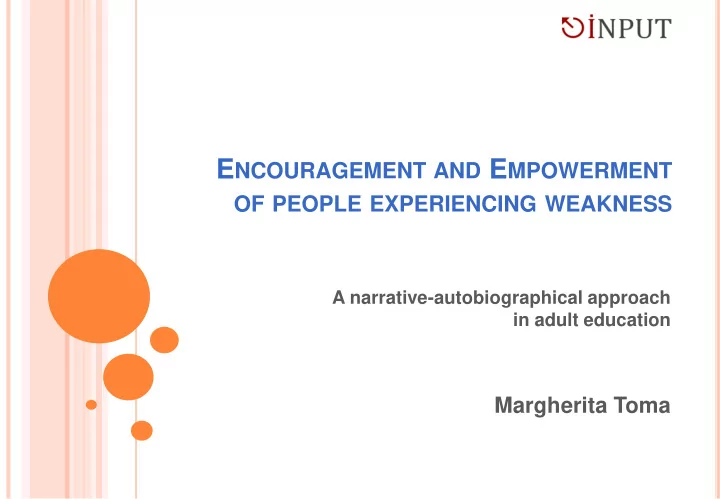

E NCOURAGEMENT AND E MPOWERMENT OF PEOPLE EXPERIENCING WEAKNESS A narrative-autobiographical approach in adult education Margherita Toma
TWO WEAK CATEGORIES Migrants and people with a migration background Suffering from prejudice and segregation in the labour market, often due to low education, low skills and their ethnic origins. Ageing workers Experiencing more difficulties both in entering and remaining in the labour market, due to prejudice on their physical and mental efficiency. Training and lifelong-learning activities are key tools in the empowerment of these two categories
THE PERSONAL AND INDIVIDUAL FACTOR People experiencing professional and educational weakness often face also a lack of self-esteem, self-confidence and life projectuality. Traditional training processes are characterised by a unidirectional and impersonal passage of information and knowledge, with no attention to the individual. The need of increasing self-esteem, self-confidence and of stimulating life projectuality is the revolutionary factor of the autobiographical approach.
THE AUTOBIOGRAPHICAL APPROACH The autobiographical approach in education consists in leading the participants to narrate themselves, their own personal histories, their own identitary, social and working context. It is a pedagogical method which aims at capturing the subjectivity, the vitality, the peculiarity of the individual, as well as his learning, transformation and self-expression paths. (L. Formenti, La formazione autobiografica)
A DIALOGIC DIMENSION The strength of such an approach is to directly involve the participants, who become active subjects of their own training/learning. The relation between trainers and trainees is not unidirectional, but rather dialogic and circular. The mentor becomes a ‘ facilitator ’ of the learning process, which is actually shaped by the participants.
WHEN IS THIS METHOD USED ? The narrative-autobiographical approach can be applied to different typologies of training and recipients: Training of weak categories 1. within educational and professional orientation and re-orientation activities. Training of mentors, 2. in order to provide them with new educational tools and training processes.
METHODOLOGY An effective training process mainly requires: Active involvement of the trainee; Identification of specific needs; capacities and aspirations; Achievement of new skills and tools in order to build new life projects. The narrative-autobiographical approach is characterised by three main phases: Self-narration; Self-recognition; Self-reinvention.
NARRATION : MODALITIES AND TOOLS Self-narration can be expressed through: Interview or verbal narration; Written narration; Video narration; Photography and image narration; Drawing and painting narration. And can be : Spontaneous or generated; Continuous or occasional; Self-oriented or open to a public; On significant events or on the entire life.
THE AUTOBIOGRAPHICAL APPROACH — OBJECTIVES Enhancing the analytical and reflection capacities on one’s own role and skills. Developing a more solid and continuous self awareness, as adults, as workers and as individuals. Increasing self-esteem and self-confidence. Investigating one’s own capacity in analysing difficulties and solving relational problems. Developing a greater capacity of reinvention at a personal and professional level.
Recommend
More recommend